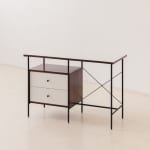






Geraldo de Barros (Unilabor)
Desk, 1950s
| Restored |
Rosewood, Formica
Rosewood, Formica
H 29.4 in. x W 42.92 in. x D 20.87 in
H 74.7 cm x W 109 cm x D 53 cm
H 74.7 cm x W 109 cm x D 53 cm
BO.GDB.003-002
Further images
This desk was produced by the pioneer company Unilabor, with components designed by Geraldo de Barros (1923-1998). Its iron structure supports a top and drawers covered with Formica – a...
This desk was produced by the pioneer company Unilabor, with components designed by Geraldo de Barros (1923-1998). Its iron structure supports a top and drawers covered with Formica – a new decorative solution developed by the industry in the period.
This desk is composed of three different components designed by De Barros: the iron structure, the top, and the box with the two drawers – each with a graceful brass handle. Other furniture pieces by Unilabor could use these same components to assemble different designs, following the company standards. The system used was part of the industrial constructive reasoning, and the brand language was common to other factories of the time. The most singular innovation appears with the conceptual conception, reasoning the production in a highly organized way.
The Unilabor community was founded in 1954 by Geraldo de Barros and a Dominican Priest. He designed and projected furniture based on his constructive references to Concrete Art. From 1954 to 1961, Unilabor is one of the standing marks in furniture design in São Paulo. Its social characteristic is well renowned, based on principles of community work.
This desk is in very good vintage condition.
This desk is composed of three different components designed by De Barros: the iron structure, the top, and the box with the two drawers – each with a graceful brass handle. Other furniture pieces by Unilabor could use these same components to assemble different designs, following the company standards. The system used was part of the industrial constructive reasoning, and the brand language was common to other factories of the time. The most singular innovation appears with the conceptual conception, reasoning the production in a highly organized way.
The Unilabor community was founded in 1954 by Geraldo de Barros and a Dominican Priest. He designed and projected furniture based on his constructive references to Concrete Art. From 1954 to 1961, Unilabor is one of the standing marks in furniture design in São Paulo. Its social characteristic is well renowned, based on principles of community work.
This desk is in very good vintage condition.






